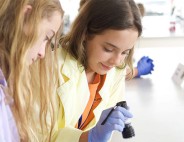Bioscience’s Bright Spots
13 Jan, 2014
By Mark Kleszczewski
Collaboration within clusters trumps competition.
Despite high failure rates, difficulties in obtaining early-stage funding and rapidly-changing market dynamics, the U.S. bioscience and biopharma industries not only weathered the recession, but actually added jobs while other knowledge-based industries lost traction.
While well-established industry clusters, such as in Massachusetts and New Jersey, continue to lead the nation in research and development jobs, federal research funding and venture capital investment per capita, smaller biotech clusters are growing at faster rates as governments increasingly court the industry as an economic development engine.
Biotech is Still Big Business
According to the Biotechnology Industry Association (BIO), the industry accounted for more than 1.6 million jobs in 2010, spanning more than 70,000 individual business establishments and supporting an additional 3.4 million jobs throughout the remainder of the economy. The U.S. biopharmaceutical sector is especially robust, accounting for the single largest share of all U.S. business R&D and nearly 20 percent of all domestic R&D, according to the National Science Foundation.
Developing innovative medicines and therapies in the U.S. remains significant, with more than 300 new medicines approved by the Food and Drug Administration in the last decade, according to the Pharmaceutical Research and Manufacturers of America (PhRMA). Member companies spent an estimated $48.5 billion in 2012 to discover and develop new medicines with roughly 2,900 compounds currently being studied in the United States alone.
BIO also indicates the highly-skilled nature and demand for bioscience jobs supports a wage growth that well outpaces that of the private sector, increasing by 13.1 percent in real terms since 2001, compared with just 4.4 percent pay raises among all other industries.
Partnerships Lead to Profit
“In the past several years, it has become more important than ever for those in our industry to form partnerships and collaborations,” says Fritz Bittenbender, executive vice president, external affairs, BIO. “Big pharma, small biotechs, universities, investors, patient groups, the NIH — everyone is recognizing that success is only achieved by working with others. One place we’ve seen this play out dramatically is in the increased number of One-on-One Partnering meetings taking place at the BIO International Convention each year. In 2013, there were a record-breaking 25,500 partnering meetings, up from about 21,000 meetings in 2011 and 14,000 meetings in 2009.”
As with other capital-intensive, research-based industries, today’s biotech companies are looking closely at the cost of labor, the presence of key suppliers in a region, the proximity of potential local or regional clients and the number of existing industry-related manufacturing companies. One of the most important things that states and localities can also do is make available tax breaks, grants and financing loans or guarantees, Bittenbender suggests.
This supports interest from investors which has increased in the sector, he says. So far this year, there have been 39 IPOs of therapeutic U.S. biotech companies, whereas there were just 13 in all of 2012. Much of this increased activity and interest has been driven by the passage of the Jumpstart Our Business Startups (JOBS) Act, which has made it easier for companies to raise capital. That’s important in an R&D intensive industry, where many companies do not yet have revenue or products on the market, Bittenbender adds.
Last year, in an effort to help bring innovative new medicines to patients more efficiently, BIO launched one of its most important initiatives, aimed at modernizing and streamlining the clinical trials process. The four key pillars of the project are: promoting centralized institutions review boards (CIRBs), regulatory qualification of drug development tools, risk-based monitoring (RBM) of clinical trials, and the creation of a pediatric clinical trial site network. This tool will enable drug developers to select the best sites to conduct their research, while giving trial sites incentives and clear benchmarks to improve their status as a research site.
Gaining prominence on the national stage in recent years is Colorado, which has grown nearly 600 medical device, diagnostic, pharmaceutical and ag-bio companies into a thriving bioscience cluster.
“Colorado has seen some good growth over the last 10 years and the state’s put in infrastructure and grant programs over the last four to five years that have been really helpful in creating momentum for all of our advanced industries, including bioscience,” says April Giles, president and CEO, Colorado BioScience Association. “Over the last two years we’ve seen our medical device community grow in employment around 15 percent and the industry as a whole at 4.5 percent, with an uptick in biopharma, which has also been great.”
In addition to a highly-educated workforce and an active venture-capital market, one of the state’s prized industry assets is the Fitzsimons Life Science District and the adjacent University of Colorado’s Anschutz Medical Campus in Aurora. Together they form a 578-acre site dedicated to bioscience, biotechnology, health care, medical education and advanced research — making it the largest development of its kind in the state and one of the largest bioscience real estate developments in the country.
Moving to Wisconsin, life science entrepreneurs can tap into a thriving biotech cluster that features more than 640 bioscience businesses supporting nearly 24,000 private sector jobs with a total economic impact of close to $7 billion.
“It’s a pretty fertile area for the industry,” says Paul Jadin, president, Madison Region Economic Partnership. “When you look at employment, we’ve got about a 1.8 location quotient for jobs in areas such as biotech research and that’s growing annually. We’re now responding to demand for a second university research park to supplement our first one, which today has $800 million dollars invested in it, with 126 companies and 3,600 employees.”
Regional sector employment is balanced between leading companies such as Covance, Thermo Fisher Scientific and GE Healthcare, and smaller companies such as Exact Sciences, Lucigen and Quintessence Biosciences. Specialty companies like SHINE Medical Technologies and Northstar Medical Radioisotopes, says Jadin, have successfully transferred products from research to market, choosing to remain in the Madison region to build manufacturing facilities and create related jobs.
The region’s life sciences sector is driven largely by the University of Wisconsin-Madison, which ranks fourth nationwide in federal research funds with more than $1 billion in expenditures, more than half of which is spent directly in ag and life sciences, Jadin notes.
Biosciences growth is also being fostered by local research, incubation and co-working spaces, such as University Research Park, Wisconsin Institutes for Discovery and T.E.C. Incubator Center and institutions such as BioForward, the Wisconsin Technology Council and the Wisconsin Alumni Research Foundation.
Over in New York, the Buffalo Niagara region is a major player in the state’s life sciences sector, with approximately 130 companies in the medical device, therapeutics and related sectors, employing more than 6,500 people. The region’s prime location between Toronto and Rochester positions it within an ever larger international biomedical industry cluster consisting of more than 650 companies, research and health care centers, and $1 billion in annual life sciences research.
“A significant trend in the biosciences is the increasing involvement of universities as drivers of regional economic growth,” says Alan Rosenhoch, business development manager, Buffalo Niagara Enterprise. “This increased role is coinciding with many of the larger pharmaceutical and medical device companies’ move towards outsourcing R&D. Smaller companies developing new technologies can leverage their own resources by partnering with our universities to attract R&D funding from the federal government and other sources.”
Local resources include 26 colleges and universities, the Buffalo Niagara Medical Campus, Hauptman-Woodward Medical Research Institute, Kaleida Health Gates Vascular Institute, the University at Buffalo’s Clinical and Translational Research Center, and the Jacobs Institute. Roswell Park Cancer Institute is also having a tremendous impact on the city’s economy, with more than 5,000 jobs created or relocated to this innovation hub since 2003 and another 5,000 expected in the next five years.
Forging Ahead Together
Communities that keep their finger on the pulse of new technologies while working together to leverage their assets, stand to gain the most.
“I think in the years ahead, we’re going to continue to see significant breakthroughs in a variety of scientific fields, including high-tech and specialized medical therapies,” Jadin says. “If you extrapolate from all the enzyme work and other research that’s being done for the pharmaceutical industry here in Madison, it suggests that we’re going to continue to see significant growth nationwide.”
“We tend to be under the radar, so it’s hard to compare us to other clusters, but when we talk about our success and who we are in the industry, it really comes back to the culture,” Giles says. “We know that we do great research and our institutions rise to the top when it comes to leveraging grant dollars, but part of why we do well is that we don’t compete with each other, even though there may be competitive technologies being developed here.
“From our leaders who have run companies for 20 years, all the way down to scientific founders who are just spinning out companies from our research institutions, there are really strong connections between those people and initiatives in Colorado to foster our growth in the industry,” Giles continues.
Mark Kleszczewski is president and CEO of GoBusiness Group LLC and a freelance writer on critical business topics. He can be reached at mark@gobusinessgroup.net.
For complete details on the organizations featured in this article, visit:
Biotechnology Industry Organization
Colorado BioScience Association
Madison (Wis.) Region Economic Partnership
Pharmaceutical Research and Manufacturers of America
Illustration by dream designs at Free Digital Photos.net
Cincinnati: Ongoing Success is in Its DNA
By Rachel Duran
Economic development leaders in the Cincinnati metro want biosciences industry members located outside the community to think of the region as a rising star in biosciences related activities. “We are gaining momentum based on location,” says Adam Singer, director of the biohealth cluster for the Cincinnati USA Partnership. “We have a pipeline of talent, and exceptional access to markets, which includes hundreds of suppliers and outsourcing firms. We pride ourselves on collaboration.”
Collaborative initiatives took center stage in the fall when Cincinnati’s biohealth stakeholders gathered to discuss what works and where the challenges exist in regard to building and maintaining a skilled talent base. The metro is home to 330 companies that fall under the partnership’s biohealth category, including medical devices, pharmaceuticals, diagnostics and clinical testing firms, and clinical research.
Results of the process include companies gaining a better handle on where to start when engaging faculty members and the higher education system; and educators encouraging industry to share their workforce requirements so that as a school year progresses, faculty can reach out to students and share positions that are available, such as lab technicians or chemists.
In regard to business growth initiatives, Singer says the majority of the region’s biohealth companies have undergone expansions in the last couple of years. The region is home to corporations including Johnson and Johnson’s Ethicon EndoSurgery, and the headquarters for Meridian Bioscience Inc. Ethicon has announced its new division, Sedasys, will locate to the metro. Other industry members are AtriCure, and AssureRx Health Inc. “We feature one of the lowest operating costs among U.S. cities with populations of 2 million or more,” Singer says. “And we can provide the resources companies need from a workforce standpoint.”
For complete details, visit www.cincinnatiusa.org.











